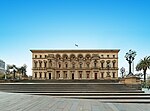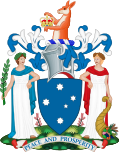1 Treasury Place

1 Treasury Place (also known as the State Government Office) is a government building in Melbourne, Victoria, Australia that was built in the 1960s and comprises five levels of office accommodation. The building was designed by architect Barry Patten of Yuncken Freeman Architects Pty Ltd. according to the internationalist style of architecture.The building is home to the Victorian Government Department of Premier and Cabinet (DPC) and Department of Treasury and Finance (DTF). The building is also home to the office of the Secretary of DTF (currently David Martine), the office of the Premier of Victoria (currently Daniel Andrews), and the office of the Treasurer of Victoria (currently Tim Pallas).
Excerpt from the Wikipedia article 1 Treasury Place (License: CC BY-SA 3.0, Authors, Images).1 Treasury Place
Old Treasury Walk, Melbourne East Melbourne
Geographical coordinates (GPS) Address Nearby Places Show on map
Geographical coordinates (GPS)
| Latitude | Longitude |
|---|---|
| N -37.812777777778 ° | E 144.97444444444 ° |
Address
Treasury Theatre
Old Treasury Walk
3002 Melbourne, East Melbourne
Victoria, Australia
Open on Google Maps










